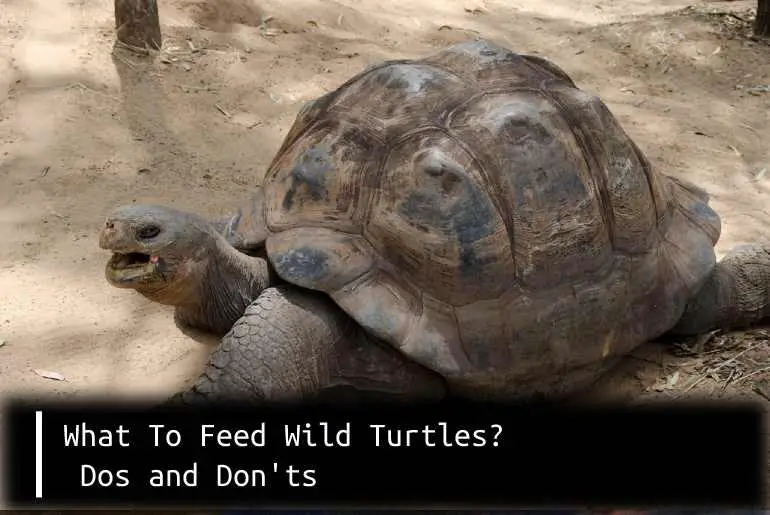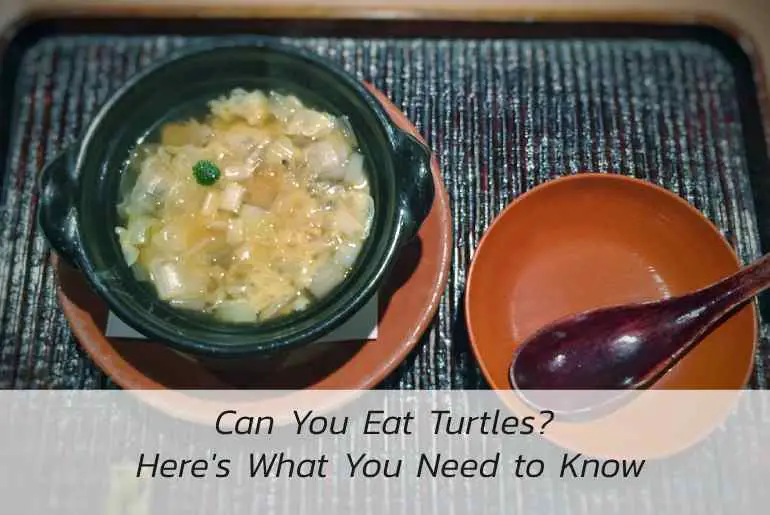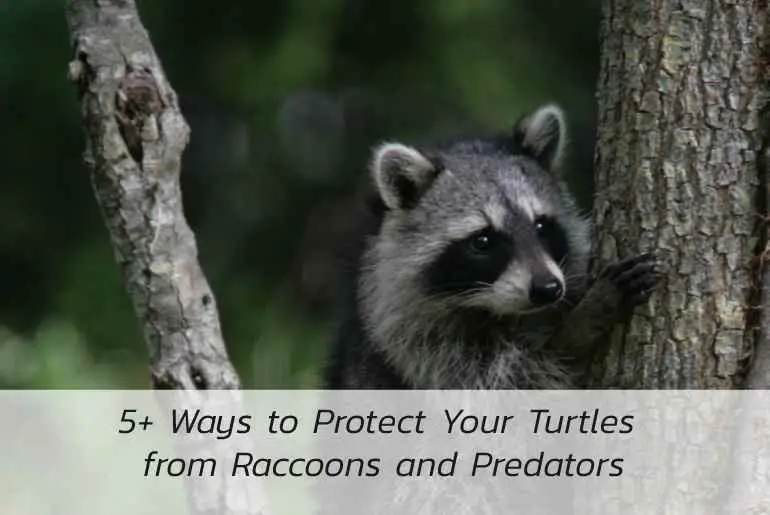One question that we often get asked is what to feed wild turtles. The answer to this question depends on the type of turtle, as different turtles have different dietary needs. However, there are some general guidelines that you can follow when feeding wild turtles.
You can feed wild turtles with pet food, but it is important to check the label first to make sure that it contains the correct nutrients for the turtle. For example, some pet food brands make special formulas for turtles that contain added calcium, which is essential for their health.
Worms are another good option for wild turtles.
What To Feed Wild Turtles?
In the wild, turtles eat a variety of insects, worms, feeder fish, small crustaceans, and leafy vegetation. While captive turtles can survive on a diet of pellets or commercial turtle food, it’s best to supplement this with live food or fresh fruits and vegetables.
Mealworms, crickets, and earthworms make a nutritious treat for turtles, and many reptiles enjoy the occasional piece of cooked chicken or steak. Leafy greens like spinach and kale are also good sources of vitamins and minerals, while fruits such as berries and melon can be fed as an occasional treat.
When selecting food for your turtle, always consult a veterinarian or experienced reptile keeper to ensure that you are providing a balanced diet.
Worms
Worms are an easy food source for turtles since they are small and abundant. Plus, turtles love the taste of worms! Some of the most popular types of worms for turtles include earthworms, nightcrawlers, and red wigglers.
While there are many different types of worms turtles can eat, it’s important to only feed them safe worms. Make sure to consult a list of safe worms before feeding them to your turtle. You should also provide them in moderation as part of a well-rounded diet.
Some of the worms you can give to your turtles are:
- Earthworms
- Mealworms
- Silkworms
- Hornworms
- Butterworms
- American Nightcrawler
- Wax worms
- Red wigglers
- Grubs
Aquatic Plants
Turtles are reptiles, so they require a diet that is high in protein and low in carbohydrates. In the wild, turtles eat a variety of insects, worms, small crustaceans, and leafy vegetation. While captive turtles can survive on a diet of pellets or commercial turtle food, it’s best to supplement this with live food or fresh fruits and vegetables.
Aquatic plants are another good food source for turtles. Many turtles are herbivores, which means that they only eat plants. Some of the most popular aquatic plants for turtles include water lettuce, duckweed, and water hyacinth.
As with all other food, you should consult a veterinarian or experienced reptile keeper before feeding aquatic plants to your turtle. This is because some plants can be toxic to turtles if they are not properly prepared.
Some of the aquatic plants you can give to your turtles are:
- Water lettuce
- Duckweed
- Water hyacinth
- Azolla
- Anacharis
- Cabbage
- Zucchini
- Squash
- Spinach
- Kale
Turtle pellets or commercial turtle food can be supplemented with live food or fresh fruits and vegetables. Feeding your turtle a variety of foods will help them stay healthy and happy.
Are There Unsafe Plants For Wild Turtles To Eat?
There are a number of plants that are poisonous to turtles if they are ingested. These plants can cause serious health problems and, in some cases, death. If you have any plants in your home or yard that you think might be poisonous to turtles, it’s best to remove them or keep them out of reach. Some of the most common poisonous plants for turtles include:
- Tulips
- Daffodils
- Hyacinths
- Lilies
- Iris
- Amaryllis
- Azaleas
- Rhododendrons
- Holly
- Mistletoe
- Yew
- Oleander
- Cyclamen
- Begonia
Insects
Turtles love to eat insects! When it comes to feeding turtles, you have a lot of options. Insects such as grasshoppers, crickets, mosquitoes, ladybugs, ants, and caterpillars are all safe for turtles to eat. Larvae are also a good option, as they are high in protein.
However, there are some insects that should be avoided. Lightning bugs, for example, contain toxins that can be harmful to turtles. So, when choosing food for your turtle friend, make sure to do your research and select items that will provide them with the nutrients they need to thrive.
Veggies
Turtles are omnivores, so they require a diet that includes both plants and animals.
Just like humans, turtles need to eat a balanced diet in order to stay healthy. For babies and juveniles, this diet is mostly carnivorous, as they need extra protein to help them grow. However, as they get older, turtles start to prefer a more vegetarian diet.
While protein is still important, veggies become an essential part of their diet as well. There are a variety of vegetables that turtles can eat, such as kale, cabbage, beetroot, and carrots.
However, it’s important to avoid feeding them vegetables with a high oxalate content, as this can prevent their bodies from absorbing calcium. Some examples of high-oxalate vegetables include spinach and okra. By providing a diverse and balanced diet, you can help keep wild turtles healthy and happy.
Cooked Meat
While turtles are mostly herbivorous, they will occasionally eat small amounts of meat. This includes cooked chicken, beef, and pork. However, it’s important to avoid feeding them raw meat, as this can increase the risk of salmonella contamination.
When feeding cooked meat to wild turtles, make sure to chop it into small pieces so they can easily eat it. You can also mix it with their regular food to make sure they’re getting all the nutrients they need.
Fruits
In addition to vegetables, wild turtles can also eat fruit. This includes apples, bananas, grapes, watermelons, and cantaloupes. As with vegetables, it’s important to chop fruits into small pieces before feeding them to your turtle.
You should also avoid giving them fruits with high sugar content, as this can lead to health problems. Some examples of high-sugar fruits include pineapple and mango. Providing various fruits and vegetables can help ensure that wild turtles get the nutrients they need to stay healthy.
You might also be interested to know more about:
Can Turtles Eat Watermelon? The Definitive Guide
Do Wild Turtles Practice Cannibalism, And If So, Why Do They Do It?
While it may seem like a scene from a horror movie, cannibalism is not uncommon in the animal kingdom. In fact, many species engage in this gruesome act, including turtles. While the exact reasons why turtles practice cannibalism are still unknown, there are a few theories that help to explain this behavior.
One theory suggests that cannibalism is a way for turtles to get rid of sick or weak individuals who would otherwise compete for resources.
Another theory suggests that turtles may eat other members of their species in times of food scarcity. Whatever the reason, it’s clear that cannibalism is a key part of turtle ecology.
Things To Consider Before Feeding Wild Turtles
There are some things you might need to consider before you feed wild turtles. They can be dangerous too! Definitely, you do not want to get hurt or hurt the turtle in return!
Do Not Get Too Close
While it may be tempting to get up close and personal with a wild turtle, it’s important to remember that these creatures can carry diseases. If you must handle a turtle, be sure to wash your hands thoroughly afterward.
Do Not Feed Them Too Much
It’s important to only give turtles the food they need. Overfeeding them can lead to health problems.
Give Them A Variety Of Foods
Turtles need a variety of foods to stay healthy. Give them a mix of proteins, vegetables, and fruits.
Avoid Feeding Turtles Food That Is High In Fat, Salt, or Sugar
These items can cause health problems for turtles. If you have any questions about how to feed a turtle, be sure to consult with a veterinarian or wildlife expert.
By following these simple tips, you can help ensure that wild turtles stay healthy and safe.
Know What’s Safe And What Is Not
While some people may think that all turtles are the same, there are actually many different species of turtles. Some turtles are more delicate than others and require special care.
Before feeding a turtle, it’s important to do some research to make sure that you are giving them the correct food.
Consult With A Professional
If you are unsure about what to feed a turtle, it’s always best to consult with a professional. They will be able to give you the most accurate information and help you make sure that the turtle is getting the nutrition they need.
Things You Should Not Feed Wild Turtles
There are some things that you should never feed a wild turtle. These include:
- Chocolate
- Candy
- Cooked chicken bones
- Dog or cat food
- Excessively salty foods
- Iceberg lettuce
- Raw meat: Since there can be bacterial infections from raw meat, it should very well be avoided for wild turtles.
- Dairy Products
- Nuts
- Processed Food
- Poisonous Plants
- Veggies High Amount Of Oxalates
Frequently Asked Questions
How Can You Tell If A Turtle Is Sick Or Injured, And What Should You Do If You Find One In This Condition?
If you find a turtle that appears to be sick or injured, there are a few things you can do to help. First, check for any obvious wounds or injuries. If the turtle has any cuts or scrapes, gently clean them with warm water and soap.
Next, check the turtle’s eyes and nose. If they are discharged or crusty, this could be a sign of an infection. Finally, take a look at the turtle’s shell.
If it is cracked or flaking, this could be a sign of a more serious problem. If you find any of these signs, it’s best to take the turtle to a vet or wildlife rehabilitator for treatment.
What Are The Different Types Of Turtles That Live In The Wild, And Where Can They Be Found Around The World?
There are many different types of turtles that can be found in the wild all over the world. The most common type of turtle is the snapping turtle, which can be found in North America, Europe, and Asia. These turtles get their name from their large mouths and powerful jaws, which they use to catch their prey.
Another type of turtle is the soft-shell turtle, which is found in Africa, Asia, and Australia. These turtles have softer shells than other turtles, which helps them move more quickly in the water.
Finally, there are tortoises, which are land-dwelling turtles that can be found in Africa, Asia, and South America. Tortoises have thick shells that protect them from predators and are known for their long lifespans. All of these different types of turtles play an important role in the ecosystem, and they can all be found in different parts of the world.
How Can You Help Protect Wild Turtles From Becoming Endangered Or Extinct?
Every year, thousands of turtles are killed for their meat, shells, and eggs. As a result, many species of turtles are now endangered or even extinct in the wild. However, there are things that people can do to help protect these creatures.
One way to help is by not buying products made from turtle parts. This includes items such as shell jewelry, leather goods, and even some traditional medicines. Another way to help is to participate in beach cleanups or other conservation efforts.
This helps to remove trash and other hazards from the turtles’ habitat. Finally, spreading awareness about the plight of wild turtles can also be helpful. Educating others about the dangers they face can promote changes that will help protect these creatures for future generations.
Conclusion
So, what do wild turtles eat? Well, that depends on their location. Turtles in the water will eat fish, frogs, and other small aquatic creatures. Land turtles typically eat insects, grubs, and other small invertebrates. Some turtles have been known to practice cannibalism, but there is no definitive answer as to why they do it.
If you find a sick or injured turtle, please contact your local wildlife rehabilitation center for help. There are many different types of wild turtles living all over the world; learn more about them and how you can help protect them by visiting our website. What was the most interesting thing you learned about wild turtles in this blog post?






